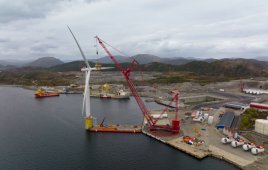By Julie Desimone, Partner, Renewable Energy Practice; Jimmie Williams, Partner, Transaction Services; Moss Adams
Federal tax credits for renewable energy are waning. The federal renewable electricity production tax credit (PTC) was supposed to end in 2019. However, Congress passed extensions of the PTC in December 2019 for projects beginning construction before December 31, 2021. Specific sectors, like the solar industry, saw the investment tax credit (ITC) drop from 30% to 26% in 2020.
The Coronavirus Aid, Relief, and Economic Security (CARES) Act — a $2 trillion stimulus plan signed into law on March 27, 2020 — won’t extend tax credits or offer direct pay provisions for solar and wind projects.
This trend is set to continue and it’s impacted the way renewable energy companies do business.
Impact of corporate influx

The 225-MW Great Western Wind Project serves Google’s data center in Oklahoma.
The renewable energy industry has been forced to pivot its business model away from federal tax benefits. In the past, companies could sell megawatts at a cheap rate and still make a decent profit because of the federal production and incentive tax credits. Now, renewable energy companies are finding secure funding for the lifespan of their assets without the federal government’s assistance or a heavily reduced level of assistance.
While the need for renewable energy remains high, primarily due to state mandates and social responsibility, corporate trends include shorter and more competitive power purchase agreements (PPAs) or renewable energy companies selling directly into the market. This creates pressure to make projects more cost and production efficient. There are new corporate players in the renewable energy market due to a variety of reasons, including social responsibility, high energy demands (data centers) and securing of more economic electric rates.
The need for renewable energy is increasing, and as costs continue to decline, corporations will see renewable energy as an attractive sector, even without tax credits.
Google is a great example of a corporation that took it upon itself to push renewable energy. It started buying long-term wind energy in 2010 and declared the company 100% reliable on renewable energy sources for global operations in 2017. Google also signed a wind and solar investment deal worth up to $2 billion in 2019 to continue to provide its campuses with electricity from renewable resources. The deal grew its green energy portfolio by 40%.
The concept of corporate sustainability is not driven entirely from a pricing standpoint; in many cases, companies continue to pay a higher price for renewable energy. They must have the desire to do their part and reduce their use of fossil fuels.
It’s more of a socioeconomic decision driven from an investor standpoint. Like Google, corporations want to be viewed as leaders that drive environmental awareness. (See Top 5 Renewable Energy Trends for 2020.)
Decreasing generation costs

120 MW of the 154-MW Rock Falls Wind Project in Oklahoma is purchased by Kimberly-Clark to power a portion of its North American manufacturing operations.
Corporations have been motivated to enter the renewable energy space because it’s seen as a new profit area. Since the reduction of renewable costs, markets are equalizing, and renewable energy has become more competitive with fossil fuels primarily due to the decreasing costs of utility-grade renewable energy generation. Price decreases come from a combination of scale in production and improvements in technology.
Wind and solar have lower or comparable total cost of generation than the majority of conventional generation sources.
Certain technologies — such as onshore wind and utility-scale solar — became cost-competitive with conventional generation several years ago on a new-build basis, and they continue to maintain competitiveness with the marginal cost of existing conventional generation technologies.
Remaining challenges
Though the renewable energy industry is stabilizing in many ways, generation demands, cost of manufacturing and state requirements are a complex, ever-moving target, and new changes to the industry arrive each day. While opportunities evolve in this sector, the industry will continue to struggle with some significant challenges.
Storage
Major questions remain about the direction of renewable energy when we look at the United States as a whole. The sector is still working to tackle the issue of cost-efficient energy storage.
While a continued decline of fossil fuels is expected, without efficient storage solutions, it’s unlikely that the use of fossil fuels will discontinue. If a cost-efficient energy storage solution is found and manufactured, it will be a significant game changer for the renewable energy industry.
Insufficient infrastructure
As plans for coal and less efficient generation term out or are retired, there’s a need for additional power generation. This raises the questions — where is it going to be generated, and is there sufficient transmission infrastructure in place to deliver the energy to the markets where it’s needed?
With the combination of renewable energy mandates and trends toward corporate sustainability, utilities are looking to fill the gap with renewable energy sources — if the utility already has a strong base load component.
However, renewable energy tends to be generated further away from where it’s needed, especially when the production is large scale. For instance, wind power is often generated out in desert areas like Palm Springs or West Texas where there’s lots of space but a low population.
You need a reliable transmission system that has capacity to get the power where it needs to go. This continues to be a challenge across the United States.
The system also needs to be designed to sustain peak periods. Wind and solar are intermittent power sources. The greatest amount of wind generation isn’t necessarily generated during times of peak demand, so until reliant and efficient energy storage is created, we need more of it.
Smart grid solutions have been introduced to the market with technology that has the capacity to help manage existing electricity in your grid. Technology like this will continue to become more important when intermittent sources like renewables become more incorporated into power grids; it will be needed to manage the energy load to ensure there’s not frequent brown or black outs.
Liquidated damages
Renewable energy companies enter into PPAs with power and utility companies to finance their projects. Utilities and corporations buy the power generation coming off the facility, but if they don’t perform on that contract, liquidated and other types of damages could go into effect.
For example, a renewable energy company might sell a certain amount of wind power to a utility company for $75/MWh for an agreed upon number of years. If the utility company fails to manage its facilities correctly and isn’t able to use the full amount of wind power in the contract, the renewable energy company could turn to the open market to sell the power. If it’s sold at $15/MWh on the open market, the utility company could be responsible for the remaining $60 of the original cost in the contract.
The city of Georgetown, Texas, experienced this issue in 2018 when it purchased 100,000 MWh, but its customers used less than 77,000.
Also, if a renewable facility doesn’t meet its minimum megawatt-hour requirements, it could be required to make the counterparty financially whole.
Looking ahead
Moving forward, the renewable energy industry will continue to increase production and the renewable energy business models will be less dependent on federal incentives.
Corporations are focused on reliability and keeping costs contained. Renewable energy companies will need to understand what’s driving other corporations to seek out renewables. The renewable energy market is unique, and the needs of a car company are very different than those of a technology company.
Are they looking to achieve a balanced portfolio? Do they want more diversification of risk? Below are some steps renewable energy companies can take as they look to the future:
- Watch contract language carefully to protect against industry changes that could have a detrimental impact on their business.
- Model scenarios that don’t involve federal tax credits.
- Gain a greater understanding of energy markets and the volatility in those markets.
- Seek better means of energy storage to increase industry demand.
 Julie Desimone, CPA, is partner at Moss Adams. She is the leader of the firm’s Power, Utilities and Renewable Energy Practice and has been providing auditing, accounting and consulting services for over 20 years. She serves clients in the energy and utility industry, including renewable energy companies. Some of her specific areas of focus include: industry analysis, advanced utility accounting, contracting, internal control evaluation, litigation support and relationship management.
Julie Desimone, CPA, is partner at Moss Adams. She is the leader of the firm’s Power, Utilities and Renewable Energy Practice and has been providing auditing, accounting and consulting services for over 20 years. She serves clients in the energy and utility industry, including renewable energy companies. Some of her specific areas of focus include: industry analysis, advanced utility accounting, contracting, internal control evaluation, litigation support and relationship management.
 Jimmie Williams is partner at Moss Adams. He has over 25 years of experience assisting middle-market companies, private equity groups and lenders with all aspects of transaction services. His experience includes financial and operational due diligence, outsourced corporate development and M&A support, dispute resolution services, lender services, restructuring services and consulting services related to debt and equity transactions. He has deep experience in all sectors of the energy industry.
Jimmie Williams is partner at Moss Adams. He has over 25 years of experience assisting middle-market companies, private equity groups and lenders with all aspects of transaction services. His experience includes financial and operational due diligence, outsourced corporate development and M&A support, dispute resolution services, lender services, restructuring services and consulting services related to debt and equity transactions. He has deep experience in all sectors of the energy industry.
Filed Under: Featured




